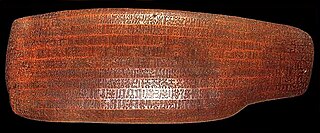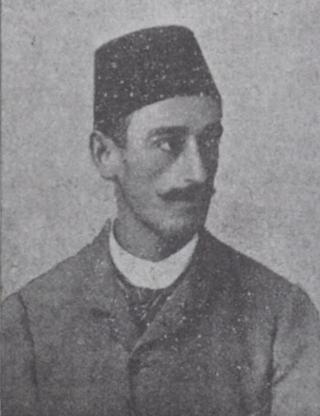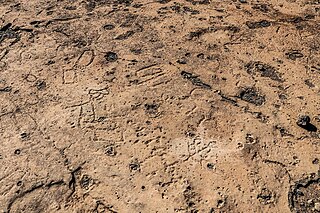Related Research Articles

Rongorongo is a system of glyphs discovered in the 19th century on Easter Island. There is no universal consensus as to whether rongorongo constitutes a writing system or proto-writing. Numerous attempts at decipherment have been made, with none being successful. Although some calendrical and what might prove to be genealogical information has been identified, none of these glyphs can actually be read. If the system is writing and proves to be an independent invention, it would be one of very few independent inventions of writing in human history.

Socotra or Saqatri is an island of the Republic of Yemen in the Indian Ocean. Lying between the Guardafui Channel and the Arabian Sea and near major shipping routes, Socotra is the largest of the four islands in the Socotra archipelago. Since 2013, the archipelago has constituted the Socotra Governorate.

The Emerald Tablet, also known as the Smaragdine Tablet or the Tabula Smaragdina, is a compact and cryptic Hermetic text. It was highly regarded by Islamic and European alchemists as the foundation of their art. Though attributed to the legendary Hellenistic figure Hermes Trismegistus, the text of the Emerald Tablet first appears in a number of early medieval Arabic sources, the oldest of which dates to the late eighth or early ninth century. It was translated into Latin several times in the twelfth and thirteenth centuries. Numerous interpretations and commentaries followed.

Hinduism has been found in the Middle East since the early 16th century. Millions of members of the Indian diaspora, of different religions, reside and work in Arab states of the Persian Gulf; many of them are Hindu. Many came due to the migration of Indians and Nepalese expatriates and employees to the area around the Persian Gulf.

Georges Émile Jules Daressy was a French Egyptologist.
The history of Socotra describes the cultures, events, peoples and strategic relevance for sea trade of what is Socotra, an island of the Republic of Yemen, currently under control of the United Arab Emirates (UAE)-backed Southern Transitional Council, a secessionist participant in Yemen's ongoing civil war. Lying between the Guardafui Channel and the Arabian Sea and near major shipping routes, Socotra is the largest of the four islands in the Socotra archipelago.

Maria Cacao is the diwata or mountain goddess associated with Mount Lantoy in Argao, Cebu, Philippines. The Maria Cacao legend is a prominent example of the mountain goddess motif in Philippine mythology; other prominent examples being Maria Makiling of Los Baños and Maria Sinukuan of Mount Arayat.

The Pitsa panels or Pitsa tablets are a group of painted wooden tablets found near Pitsa, Corinthia (Greece). They are the earliest surviving examples of Greek panel painting.

Text S of the rongorongo corpus, the larger of two tablets in Washington and therefore also known as the Great or Large Washington tablet, is one of two dozen surviving rongorongo texts.

Lussac-les-Châteaux is a commune in the Vienne department in the Nouvelle-Aquitaine region in western France.

Adam Christiaensz Pynacker or Pijnacker was a Dutch Golden Age painter, mostly of landscapes.
Sistema Cheve is a deep cave located in the Sierra Juárez mountain range in the southern Mexico state of Oaxaca. As of June 2023, its deepest point has been measured at 1,529 metres (5,016 ft) deep, This makes it the second deepest known cavern in Mexico and the Americas, as well as the world's 11th deepest cave. More than 55 miles (89 km) of passageways have been mapped within the cave.
Adventure Isle is an artificial island in the center of Adventureland at Disneyland Paris. It opened with the park in 1992.
Alain Desreumaux is a French historian of religion, specializing on Syrian and Aramaic christo-palestinian communities. He has uncovered manuscripts and inscriptions and published works on codicology and epigraphy.

Folx-les-Caves ; in Walloon Få-les-Cåves or Fô-les-Cåves) is a village in the Belgian municipality of Orp-Jauche located in Wallonia in the province of Walloon Brabant.
The Akademische Verlagsgesellschaft in Leipzig was an important German academic publisher, which was founded in 1906.
De Geest may refer to:

The Hoq Cave or Hawk Cave is a limestone cave on the island of Socotra, Yemen. It is located in the Hala spot approximately 1.5 km from the north-eastern coast facing the open sea to north-east. Clearly visible from the sea, but of difficult access, it is situated in an altitude of 350 m. The about 2 km deep cave has a main passage with a mean width of 50 m and a mean height of 20 m. 200 m from the entrance is the limite d’éclairement. The temperature is constant during the year and varies between 25 and 27 °C with a humidity higher than 95%.

The Eriosh Petroglyphs or Iryosh Petroglyphs or petroglyphs of Ariyūsh are a group of petroglyph carvings in the north-western coastal plain of Socotra island, Yemen. The group consists of pecked or carved graffiti, feet, geometric and crucial shapes, animals and anthropomorphs. The site is of unknown origin and age.
DJE 23 is a Hebrew inscription found in the village of Bayt Hadir, 15 km southeast of Sanaa, Yemen. It dates to the period of the Himyarite Kingdom in which the ruling class had converted to Judaism, or sometime between 380 and 530. It is a mishmarot which lists the priestly divisions based on the list given in 1 Chronicles 24. The priestly divisions refer to the way in which the priests were divided in order to organize their service to the Temple in Jerusalem.
References
- ↑ Robin, Christian Julien; Gorea, Maria (2002). "Les vestiges antiques de la grotte de Hôq (Suqutra, Yémen) (note d'information)". Comptes rendus des séances de l'Académie des Inscriptions et Belles-Lettres . 146 (2): 409–445.
- ↑ Gorea, Maria (2015-01-01). "Palmyra and Socotra, Foreign Sailors on Socotra, herausgegeben von I. Strauch, Bremen, Hempen, 2012, p. 447-457, 463-482". Academia.edu. Retrieved 2023-12-29.